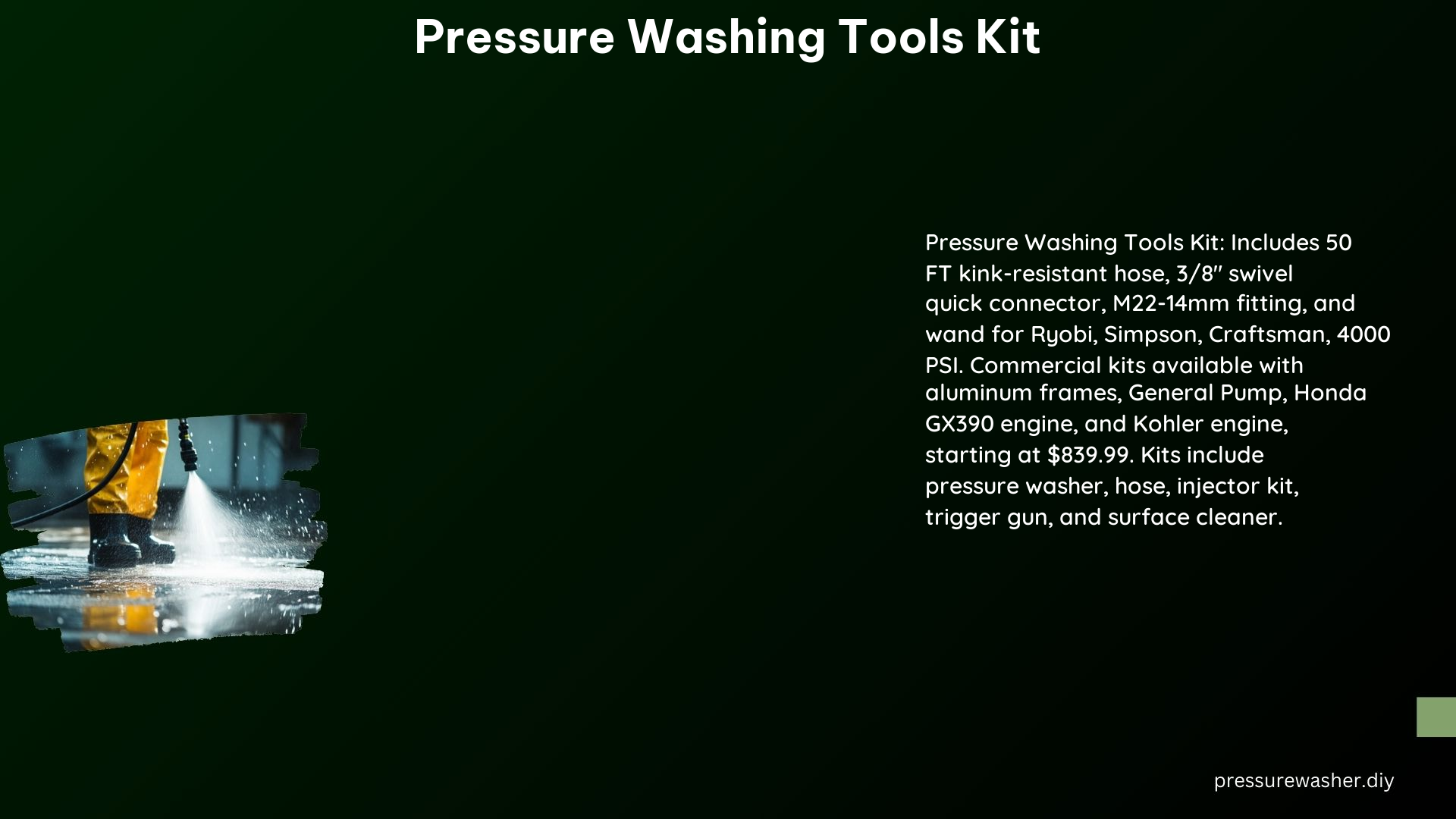A pressure washing tools kit is a comprehensive set of equipment designed for efficient cleaning and maintenance of various surfaces, from delicate vinyl siding to heavy-duty concrete. These kits typically include a powerful pressure washer, high-pressure hoses, versatile spray guns, adjustable lances, and an array of specialized nozzles and accessories to tackle a wide range of cleaning tasks.
Essential Tools in a Pressure Washing Kit
1. Pressure Washer
The pressure washer is the heart of the kit, generating the high-pressure water flow that is the key to effective cleaning. These machines come in a variety of types, including electric, gas, and diesel-powered models, with a wide range of PSI (pounds per square inch) and GPM (gallons per minute) ratings to suit different cleaning needs.
Key Specifications:
– PSI Range: 1,500 to 4,000 PSI
– GPM Range: 1.5 to 4.0 GPM
– Power Source: Electric (120V), Gas (Honda GX390 engine), or Diesel
– Portability: Wheeled or cart-mounted for easy maneuverability
2. High-Pressure Hoses
The high-pressure hoses connect the pressure washer to the spray gun, allowing you to reach and clean various surfaces. These hoses are available in different lengths (25 ft to 100 ft) and diameters (3/8″ or 1/2″), with features like kink-resistance and non-marking materials for enhanced durability and ease of use.
Key Specifications:
– Hose Length: 25 ft, 50 ft, 75 ft, or 100 ft
– Hose Diameter: 3/8″ or 1/2″
– Material: Reinforced rubber or thermoplastic
– Features: Kink-resistant, non-marking, and abrasion-resistant
3. Spray Guns
The spray gun is the handheld device that allows you to direct the high-pressure water stream onto the surface being cleaned. It typically includes a trigger mechanism and may be paired with a lance or wand for added reach and control.
Key Specifications:
– Trigger Type: Soft-grip or ergonomic design
– Lance Length: 12″ to 36″
– Material: Durable, corrosion-resistant metals and plastics
4. Lances and Wands
Lances and wands are extensions of the spray gun, providing additional reach and precision when cleaning. They come in various lengths and can be made of lightweight aluminum or sturdy stainless steel.
Key Specifications:
– Lance Length: 12″, 18″, 24″, or 36″
– Material: Aluminum or stainless steel
– Features: Adjustable, rotating, or telescoping designs
5. Nozzles
Interchangeable nozzles with different spray patterns and sizes allow you to adjust the water pressure and coverage area to suit the specific cleaning task. Common nozzle types include 0°, 15°, 25°, and 40° patterns.
Key Specifications:
– Nozzle Angle: 0°, 15°, 25°, or 40°
– Nozzle Size: 1/4″ quick-connect
– Material: Durable, corrosion-resistant brass or stainless steel
6. Quick Connectors
Quick connectors enable fast and easy attachment and detachment of hoses, lances, and other accessories, improving the efficiency and versatility of your pressure washing kit.
Key Specifications:
– Connection Type: 1/4″ or 3/8″ quick-connect
– Material: Brass or stainless steel
7. Chemical Injectors
Some pressure washing kits include chemical injectors, which allow you to apply cleaning solutions or detergents directly through the pressure washer for enhanced cleaning power.
Key Specifications:
– Injection Rate: Adjustable to control the amount of cleaning solution
– Material: Corrosion-resistant brass or stainless steel
8. Surface Cleaners
Surface cleaners are specialized tools designed for cleaning large, flat areas like driveways, sidewalks, and decks. They feature rotating or oscillating spray patterns to cover more surface area efficiently.
Key Specifications:
– Cleaning Width: 12″ to 20″
– Spray Pattern: Rotating or oscillating
– Material: Durable, corrosion-resistant plastics and metals
Choosing the Right Pressure Washer for Your Cleaning Needs

When selecting a pressure washing tools kit, it’s essential to consider the specific cleaning tasks you’ll be performing and the surfaces you’ll be working on. Here are some key factors to consider:
1. Surface Type
Different surfaces require different levels of pressure and water flow rates. Delicate surfaces like vinyl siding may require lower pressure (1,500-2,000 PSI) to avoid damage, while heavy-duty cleaning of concrete or masonry may call for higher pressure (3,000-4,000 PSI).
2. PSI and GPM Ratings
Choose a pressure washer with the appropriate PSI and GPM ratings for your cleaning needs. Higher PSI and GPM ratings generally indicate more cleaning power, but they may also require more power and fuel consumption.
3. Power Source
Decide between electric, gas, or diesel-powered pressure washers based on your power availability, mobility requirements, and the scale of your cleaning projects. Electric models are suitable for light-duty tasks and indoor use, while gas and diesel-powered units offer more power and portability for outdoor, heavy-duty cleaning.
4. Hose Length and Material
Select a hose length that suits the size of your cleaning area, and consider kink-resistant and non-marking hoses for easier maneuverability and reduced risk of damage to surfaces.
5. Additional Accessories
Evaluate the types of nozzles, lances, surface cleaners, and other accessories you’ll need to tackle your specific cleaning tasks effectively.
Technical Specifications of Pressure Washing Tools Kits
Here’s an example of the technical specifications for a high-performance pressure washing tools kit:
- Pressure Washer: 4,000 PSI, 4 GPM, gas-powered with a Honda GX390 engine
- Hose: 50 ft, 3/8″ diameter, kink-resistant, non-marking
- Spray Gun: Soft-grip trigger gun with a 24″ lance assembly
- Nozzles: 5 color-coded 1/4″ quick-connect nozzles (0°, 15°, 25°, 40°, and soap)
- Surface Cleaner: 15″ BE Whirl-A-Way surface cleaner with rotating spray pattern
